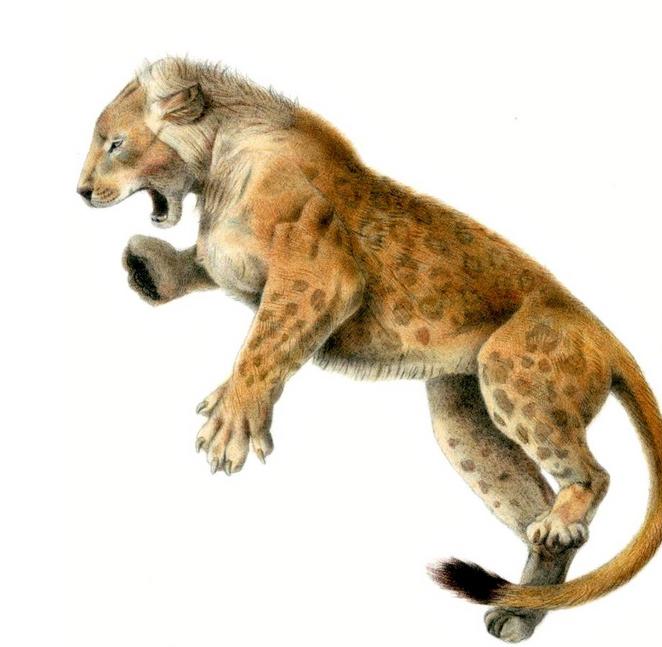Thousands of years ago, the planet Earth was inhabited by various animals, which then became extinct for various reasons. Now these animals are often called fossils. Their remains in the form of preserved bones of the skeleton and skulls are found during archaeological excavations. Then scientists painstakingly collect all the bones together and try in this way to restore the appearance of the animal. In this they are helped by cave paintings, and even primitive sculptures left by ancient people who lived at the same time. Today, computer graphics have come to the aid of scientists, allowing you to recreate the image of a fossil animal. The cave lion is one of the species of ancient creatures that terrified smaller brethren. Even primitive people tried to bypass its habitat.
Fossil predator cave lion
It was in this way that the oldest species of fossil predator, which scientists called the cave lion, was discovered and described. The remains of the bones of this animal were found in Asia, Europe and North America. This allows us to conclude that the cave lion inhabited a vast territory, from Alaska to the British Isles. The name that received this species turned out to be justified, because it was in the caves that the majority of its bone remains were found. But only the wounded and dying animals left for the caves. They preferred to live and hunt in open spaces.
Discovery story
The first detailed description of the cave lion was made by Russian zoologist and paleontologist Nikolai Kuzmich Vereshchagin. In his book, he spoke in detail about the genus of this animal, the geography of its distribution, habitats, feeding habits, breeding and other details. This book, entitled “Cave Lion and its History in the Holarctic and within the USSR”, was written on the basis of many years of painstaking research and is still the best scientific work on the study of this fossil animal. Scientists call a significant part of the northern hemisphere haloarctic.
Animal description
The cave lion was a very large predator, weighing up to 350 kilograms, height at the withers of 120-150 centimeters and body length up to 2.5 meters, excluding the tail. Powerful legs were relatively long, which made the predator a tall animal. His coat was smooth and short, its color was even, one-color, sand-gray, which helped him disguise himself during the hunt. In winter, the fur cover was more magnificent and saved from the cold. Cave lions did not have manes, as evidenced by cave paintings of primitive people. But the brush on the tail is present in many drawings. An ancient predator instilled horror and panic in our distant ancestors.
The head of the cave lion was relatively large, with powerful jaws. The dental system of fossil predators looks the same as modern lions, but the teeth are still more massive. Two fangs on the upper jaw are striking in their appearance: the length of each fang of the animal was 11–11.5 centimeters. The structure of the jaws and the dental system unequivocally proves that the cave lion was a predator and could cope with very large animals.
Habitats and hunting
The cave paintings very often depict how a group of cave lions pursues one victim. This suggests that predators lived in prides and practiced collective hunting. An analysis of the remains of animal bones found in the habitats of cave lions shows that they attacked deer, elk, bison, tours, yaks, musk ox and other animals that were found in this particular area. Their prey could be young mammoths, camels, rhinos, hippos and cave bears. Scientists do not exclude the possibility of attacks by predators on adult mammoths, but only under favorable conditions. Especially for primitive people, the cave lion did not hunt. A person could become a victim of a predator when the beast entered the shelter where people lived. Usually only sick or old individuals climbed into the caves. Alone, a person could not cope with a predator, but collective protection using fire could save people or some part of them. These extinct lions were strong, but this did not save them from imminent death.

Possible causes of extinction
The mass death and extinction of cave lions occurred at the end of the period, which scientists call the late Pleistocene. This period ended about 10 thousand years ago. Even before the end of the Pleistocene, mammoths and other animals, which are now called fossils, also completely became extinct. The causes of the extinction of cave lions are:
- climate change;
- landscape transformations;
- activity of primitive man.
Climatic and landscape changes disrupted the habitual habitat of the lions themselves and the animals they fed on. Food chains were broken , which led to the mass extinction of herbivores that lost the necessary food, and predators began to die out after them.
Man as a cause of mass death of fossil animals for a long time was completely not considered. But many scientists pay attention to the fact that primitive people constantly developed and improved. New types of weapons and hunting appeared, and hunting techniques improved. Man began to feed on herbivores and learned to resist predators. This could lead to the extermination of fossil animals, including the cave lion. Now you know which animals became extinct as human civilization developed.
Given the destructive influence of man on nature, the version of the involvement of primitive people in the disappearance of cave lions does not seem fantastic today.